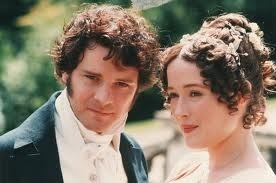Kristine Hughes's Blog, page 136
November 16, 2011
In Praise of Alan Rickman
Here in the US, Masterpiece on PBS recently presented The Song of Lunch starring Alan Rickman and Emma Thompson. A BBC dramatization of Christopher Reid's poem, the program was unique, in my (Victoria, here) view. Poetry. On tv. Brilliant acting. Emma. And Alan. Sigh.
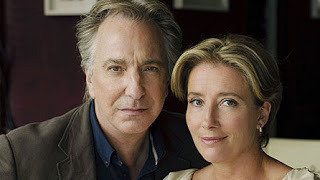
I consider myself a charter member of the Alan-Rickman-can-do-no-wrong Club. Though he has been cast in some unsavory roles, to me he is always a hero. As "he" in The Song of Lunch, Rickman portrays a self-pitying character who meets a former lover (Thompson) in an unsuccessful encounter for which he had some unrealistic expectations.

By the way, Alan, I am available for lunch in Soho almost any time -- just e-mail me right here. And figure in enough time for me to fly across the pond -- and have my hair done.
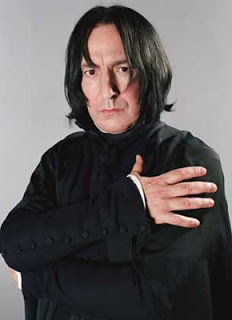
Sad to say, I haven't kept up with the character development of Severus Snape, the role that most young people will associate most with Rickman. He was a villain early on, but I believe he evolved into a very good guy in Harry Potter's world.

Villain-wise, however, I choose the Sheriff of Nottingham in the 1991 film Robin Hood, Prince of Thieves. There's a dastardly fellow we can all love. If we can stop laughing long enough.
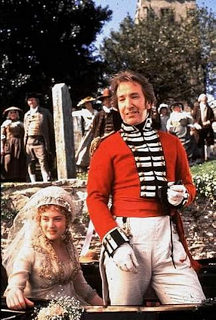
And just about my favorite of Rickman's many film roles is that of Col. Brandon in the 1996 version of Sense & Sensibility, a role that forever altered my view of Jane Austen's first published novel. Until I saw -- and heard -- Rickman wooing Marianne and confessing to Elinor, I had felt only moderate interest in and compassion for Brandon. But now I can never think of Brandon without seeing and hearing Alan Rickman. Which makes Marianne's obsession with the shallow Willoughby even more foolish -- and her reluctance to immediately adore Brandon almost impossible to accept. That's one of the drawbacks to watching filmed versdions of favorite novels, isn't it? Can anyone think of Darcy again without seeing Colin Firth?
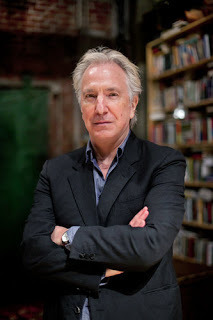
I think I read that Rickman is bound for Broadway soon -- so Alan, maybe we could have that luncheon in New York? Just name that date!!
I am expecting to have to arm-wrestle a few of our regular readers to win this encounter. I'm ready!!
But weiat, there's more! Gambit will be coming out soon (?). A remake of the 1966 Michael Caine/Shirley MacLaine caper film, this new version stars Alan Rickman, Colin Firth, Stanley Tucci and Cameron Diaz, among others. The Coen Brothers are involved -- but I couldn't find a set release date. 2012 is all I found. Let's hope it is as soon as possible!!

I consider myself a charter member of the Alan-Rickman-can-do-no-wrong Club. Though he has been cast in some unsavory roles, to me he is always a hero. As "he" in The Song of Lunch, Rickman portrays a self-pitying character who meets a former lover (Thompson) in an unsuccessful encounter for which he had some unrealistic expectations.

By the way, Alan, I am available for lunch in Soho almost any time -- just e-mail me right here. And figure in enough time for me to fly across the pond -- and have my hair done.

Sad to say, I haven't kept up with the character development of Severus Snape, the role that most young people will associate most with Rickman. He was a villain early on, but I believe he evolved into a very good guy in Harry Potter's world.

Villain-wise, however, I choose the Sheriff of Nottingham in the 1991 film Robin Hood, Prince of Thieves. There's a dastardly fellow we can all love. If we can stop laughing long enough.

And just about my favorite of Rickman's many film roles is that of Col. Brandon in the 1996 version of Sense & Sensibility, a role that forever altered my view of Jane Austen's first published novel. Until I saw -- and heard -- Rickman wooing Marianne and confessing to Elinor, I had felt only moderate interest in and compassion for Brandon. But now I can never think of Brandon without seeing and hearing Alan Rickman. Which makes Marianne's obsession with the shallow Willoughby even more foolish -- and her reluctance to immediately adore Brandon almost impossible to accept. That's one of the drawbacks to watching filmed versdions of favorite novels, isn't it? Can anyone think of Darcy again without seeing Colin Firth?

I think I read that Rickman is bound for Broadway soon -- so Alan, maybe we could have that luncheon in New York? Just name that date!!
I am expecting to have to arm-wrestle a few of our regular readers to win this encounter. I'm ready!!
But weiat, there's more! Gambit will be coming out soon (?). A remake of the 1966 Michael Caine/Shirley MacLaine caper film, this new version stars Alan Rickman, Colin Firth, Stanley Tucci and Cameron Diaz, among others. The Coen Brothers are involved -- but I couldn't find a set release date. 2012 is all I found. Let's hope it is as soon as possible!!
Published on November 16, 2011 02:00
November 14, 2011
On The Shelf - High Rising
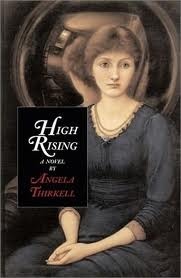
I've just re-read Angela Thirkell's High Rising and realized that I'd made a huge mistake - I read it without having any more of the Barsetshire novels on hand to read next. I then spent a good hour online, ordering six more titles in the series. Honestly, these novels, and the characters therein, are pure joy. Another thing I only recently realized - penned in the 1930's, these stories are now eighty years old, but they still read as funny and the characters are just as amusing as any 21st century counterparts. Like E.F. Benson and P.G. Wodehouse, Thirkell takes us back to an England where conversation is witty and entertaining, where plots are relatively simple (yet infinitely engaging) and where villians, if there are any, are really rather harmless, except to themselves. Everyone gets their comeuppance, everything comes right in the end and we, the readers, are thoroughly entertained throughout.
Oft compared to our own Jane Austen, Ms. Thirkell is a genius at setting place, crafting a plot and at writing sometimes over-the-top yet wholly believable dialogue. After reading any of the Barsetshire novels, who wouldn't want to spend a few weeks in the English countryside?
From the Powell's Books website: "In High Rising, Mrs. Morland, a widowed author, must attend to the deeper problems of country life while her son Tony drives everyone to distraction with his amazing combination of toy trains. Here Mrs. Thirkell demonstrates the characteristic style for which she is known and for which readers love her. This is fiction replete with gentle irony, grave absurdity, and urbane understatement. This novel introduces one of Angela Thirkell's most beloved characters--Laura Morland, a novel-writing widow and mother of four who strongly resembles Thirkell herself. In High Rising, Laura receives a marriage proposal from her publisher, who really loves Sibyl, the daughter of Laura's neighbor; Dr. Ford has feelings for Laura's secretary, Anne; and attractive but neurotic Una is determined to marry her employer. And in Tony, Laura's youngest son, Thirkell has created one of the most exasperating small boys in fiction. This is the first of the Barsetshire novels."
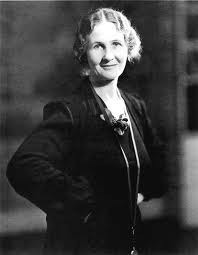 If you haven't yet read Thirkell (above), do. If you have, read them again. Oh, Barsetshire is sheer bliss. You can learn more about Angela Thirkell at the Thirkell Society's website here.
If you haven't yet read Thirkell (above), do. If you have, read them again. Oh, Barsetshire is sheer bliss. You can learn more about Angela Thirkell at the Thirkell Society's website here.
Published on November 14, 2011 00:58
November 12, 2011
Grosvenor Prints
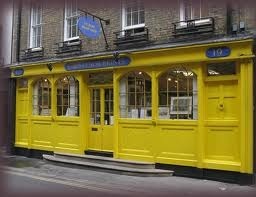
Once again, Grosvenor Prints, London, has some eclectic and interesting new stock. Grosvenor Prints, in Seven Dials, is one stop I always make when in London. When there last, Vicky and I spent a few enjoyable hours pouring over their stock - she looking at fashion prints, whilst I combed through their Wellington files. Samples of their latest acquisitions for sale can be seen below. Click here to see all of their new listings.
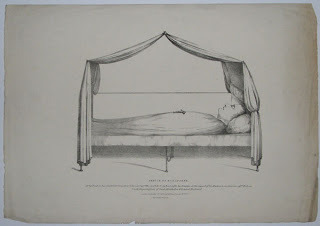
Sketch of Bonaparte. As laid out on his Austerlitz Camp Bed, taken by Capt.n Marryatt R.N., 14 hours after his Decease, at the request of Sir Hudson Lowe, Governor of St Helena & with the permission of Count Montholon & General Bertrand. C. Hullmandel's Lithography. London Published by S. & J. Fuller, 34 Rathbone Place, July 16 1821. Lithograph, fine, sheet Printed area 265 x 300mm, 10½ x 11¾". Full uncut sheet bearing the embossed stamp for "S & J Fuller". Napoleon died, reportedly of stomach cancer, on 5 May 1821 after six years in exile on St Helena. His body was buried first in the grounds of Longwood, his St Helena residence, before being brought back to France in 1840 to be ceremoniously reburied in Les Invalides. Marryat was a naval officer, and later the author of 'Peter Simple, Mr Midshipman Easy', and other popular seafaring novels, and later children's books. At the time of Napoleon's death he commanded the sloop 'Beaver', guardship at St Helena. When the ex-emperor died he carried the dispatches announcing the death back to England. The fact that Marryat visited and sketched Napoleon so soon after his death illustrates the continued fascination and emotion Napoleon evoked back in Britain, even after six years in remote exile away from the public glare. See NMM: PAF3523. {f: 21864] £280.00
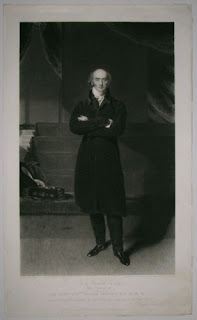 To the Viscountess Canning This Portrait of The Right Honble. George Canning, M.P. Painted by Sir Thomas Lawrence, P.R.A. Principal Painter in Ordinary to His Majesty, Engraved by Charles Turner, A.R.A. Mezzotinto Engraver in Ordinary to His Majesty, Pall Mall East, London, Published April 9, 1829, by Messrs. Colnaghi Son & Co, Printsellers to the King. Mezzotint, final state, image 580 x 355mm. 22¾ x 14". Some mould spots and foxing. Tatty and chipped margins.
To the Viscountess Canning This Portrait of The Right Honble. George Canning, M.P. Painted by Sir Thomas Lawrence, P.R.A. Principal Painter in Ordinary to His Majesty, Engraved by Charles Turner, A.R.A. Mezzotinto Engraver in Ordinary to His Majesty, Pall Mall East, London, Published April 9, 1829, by Messrs. Colnaghi Son & Co, Printsellers to the King. Mezzotint, final state, image 580 x 355mm. 22¾ x 14". Some mould spots and foxing. Tatty and chipped margins. Fine full-length portrait of statesman George Canning (1770 - 1827), Foreign Secretary, Prime Minister for 119 days, the shortest term ever. After Sir Thomas Lawrence (1769 - 1830).
Whitman 95, v of v. [Ref: 21797] £280.00
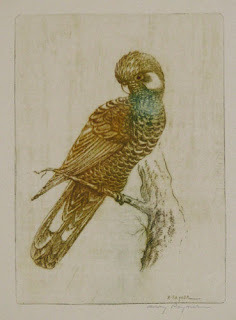
A Cockatoo - Henry Rayner [signed in plate and in pencil to margin.] [n.d., c.1940.] Drypoint etching printed in colours, 170 x 125mm. 6¾ x 5". A fine impression. A cockatoo is any of the 20 bird species belonging to the family Cacatuidae. Along with the Psittacidae family (the true parrots), they make up the order Psittaciformes. Cockatoos have a much more restricted range than the true parrots, occurring naturally only in Australia and nearby islands. Eleven of the 21 species exist in the wild only in Australia, while seven species occur in Indonesia, New Guinea, and other south Pacific islands. Henry Hewitt Redstone Rayner (1902 - 1957). Australian-born, he worked in the Antipodes before studying at the Royal Academy. He was a friend of Sickert. [Ref: 22521] £75.00
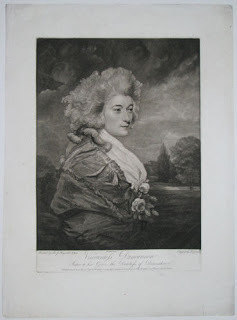
Viscountess Duncannon. Painted by Sir J. Reynolds P.R.A. Engraved by J. Grozer. Wm. Austin excudit. Published as the Act directs March 31st 1786 by Wm Austin Drawing Master, Engraver & Print Merchant No.195 Piccadily near St Jamess Church London. Mezzotint, final state with altered publication line, 390 x 275mm. 15¼ x 7". A fine impression with full margins. Portrait of Henrietta Frances ('Harriet') Ponsonby (née Spencer), Countess of Bessborough (1761 - 1821), an amateur etcher; standing in a landscape, looking to the right, with flowers attached to the front of her shawl. After Sir Joshua Reynolds (1723 - 1792). Hamilton p.96, III of III. CS: 8, iii/iii. [Ref: 22388] £280.00
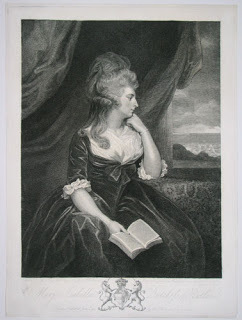
Mary Isabella, Duchess of Rutland. Painted by Sir Joshua Reynolds, & Engraved by the late J.K.Sherwin, Historical Engraver to his Majesty, & his royal highness the Prince of Wales, finish'd since his decease. London Published June 4th. 1791 by Robt. Wilkinson No. 58 Cornhill.Engraving, very fine published state, 510 x 380mm. 20 x 15" Mary Isabella Manners (née Somerset), Duchess of Rutland (1756 - 1831), politician and society hostess; seated to right with her head in profile, resting on her left hand, a book in her right; seascape through window behind. After Sir Joshua Reynolds (1723 - 1792). Hamilton p.129. NPG D39956. [Ref: 21779] £320.00
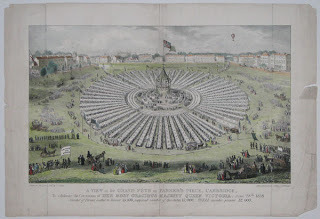
A View of the Grand Fête on Parker's Piece, Cambridge, To celebrate the Coronation of Her Most Gracious Majesty Queen Victoria, June 28th 1838. Number of Persons seated to Dinner 15,000, supposed number of Spectators 17,000, _ Total number present 32,000. [& Admission ticket] A Dinner Given to 12000 Persons on Parker's Piece, Cambridge, June 28, 1838. In Commemoration of the Coronation of Her Most Gracious Majesty Victoria Queen. Drawn on the Spot & Lith.d by G Scharf. Metcalfe & Palmer, Lithog. Cambridge. [&] Rog. sculp.t. Cambridge. [n.d., c.1838.] Coloured lithograph. Printed area 185 x 270mm, 7¼ x 10½". & engraved admission ticket on card very scarce, 115 x 150mm, 4½ x 6". Binding folds, one split, tears in edges. A formal dinner on Parker's Piece, a 25-acre common near the centre of Cambridge, England, named after a college cook, Edward Parker, who obtained the rights to farm on it. [Ref: 22318] £160.00
Published on November 12, 2011 00:48
November 10, 2011
For Sale: Ayton Castle
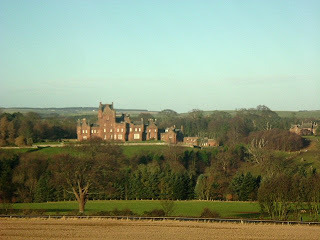
Castle, houses, lodges, cottages and fishing in the Scottish Borders Yes, yes, I've been at it again - property browsing on a grand scale. But you must admit, the sale of Ayton Castle is the perfect opportunity for anyone with dreams of playing Monarch of the Glen to own their very own family pile.
Ayton Castle comes complete with aself-contained flat and grounds extending to 159 acres, 4 houses/cottages, 2 lodges, stable yard with 2 flats and various outbuildings. Fishing on The Eye Water, private garden and extensive policies with good grazing.
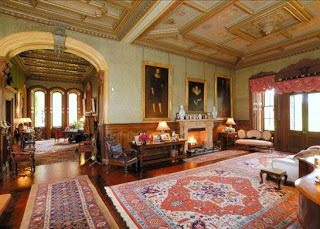
As property agents Knight Frank tell us, Ayton Castle has 7 main reception rooms, 17 bedrooms, 9 bathrooms, kitchen/breakfast room, billiards room, extensive domestic offices and a self-contained house keeper's flat. There are 2 lodges and 4 estate houses/cottages. There is a traditional stone-built stable yard with 2 flats.
Ayton Castle is widely regarded as one of Scotland's finest baronial style buildings and was designed by James Gillespie Graham, Scotland's leading Gothic revival architect of the early 19th century. The Castle is a magnificent example of a Scots baronial house, primarily over two storeys, with a five storey 'Great Tower.'
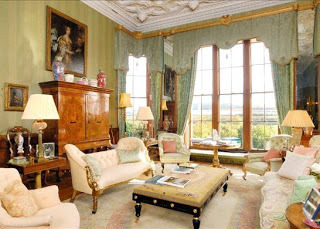
There is an array of secondary accommodation at the lower ground floor and basement/courtyard levels including the former servants hall and various store rooms and adjacent accommodation arranged around the service courtyard. Approximately half the policies are grazing and half are woodland, all of which are in hand.
As the Berwickshire News reported on Sunday: "The Liddell-Grainger family has continued to own the castle throughout the 20th century, but with the death of David Liddell-Grainger in 2007, the estate and the family seem to have encountered turbulent times, resulting in the castle being put on the property market.
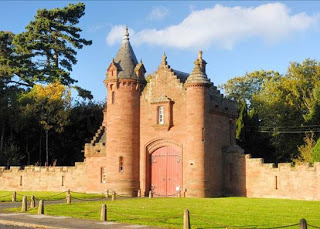
"The private life of David Liddell-Grainger has been colourful and an affair with Christine de la Rue, wife of Sir Eric de la Rue, resulted in him divorcing his wife in 1981 and Christine moving into the castle along with her elderly husband who by this time required nursing care. David Liddell Grainger and Christine de la Rue had two children together, one of whom died of cancer as a child.
"They married in 1996 and when he died 11 years later it is believed that David Liddell-Grainger left his 6000 acre estate to his son by Christine de la Rue rather than his eldest son by his first marriage.
"Last month a Private Rented Housing Panel issued an enforcement notice which ordered Henry Liddell-Grainger and Lady Christine de la Rue to carry out immediate repairs on two cottages on Ayton Castle estate. Tenants had complained of leaking roofs, damp and a two page catalogue of essential repairs that were needed to bring the properties up to a habitable standard."
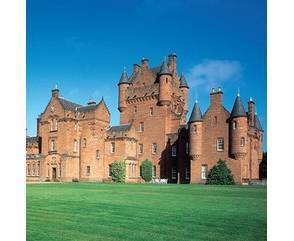
Tenant issues aside, Ayton Castle would make the perfect backdrop for a life of baronial splendour. Never mind the massive heating bills - that's what fireplaces are for.
You can watch a video of the stunning Castle grounds here.
Offers Over £2,200,000 - Knight Frank
Published on November 10, 2011 00:30
November 8, 2011
Speaking of Bridget Jones . . . .
Published on November 08, 2011 00:36
November 6, 2011
The Death of Princess Charlotte, 6 November 1817
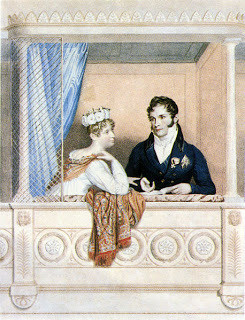
Princess Charlotte Augusta of Wales lived a short and largely unhappy life. But she was always popular with the people and the outpouring of public grief following her sad demise was immense. Some have compared it to an early 19th century version of the widespread mourning over the death of Diana, Princess of Wales, in 1997.
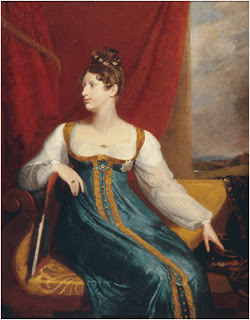 Above, Princess Charlotte by artist George Davis, c. 1817, in the royal collection.
Above, Princess Charlotte by artist George Davis, c. 1817, in the royal collection.Last year on this date, we posted an extensive story about Princess Charlotte -- click here to read the whole story.
While researching my recent talk "The Sensible Regency Wedding" for the 2011 JASNA AGM in Ft. Worth, I found the account Princess Charlotte wrote to her friend Margaret Mercer Elphinstone about reading Sense & Sensibility, Jane Austen's first published novel, which came out on October 31, 1811.
In her letter of January 22, 1812, the Princess wrote: " 'Sence and Sencibility' I have just finished reading; it certainly is interesting, & you feel quite one of the company. I think Maryanne & me are very like in disposition, that certainly I am not so good, the same imprudence, &c, however remain very like. I must say it interested me much."
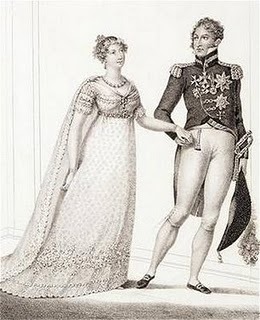 Engraving of Charlotte and Leopold at their 1816 wedding
Engraving of Charlotte and Leopold at their 1816 weddingAs can be deduced from the quotation above, the Princess, who had just turned age 16, was not yet completely at ease with grammar or spelling! Her life was difficult, a pawn between her waring parents, George, Prince of Wales, the Prince Regent (later George IV) and Caroline of Brunswick, Princess of Wales.
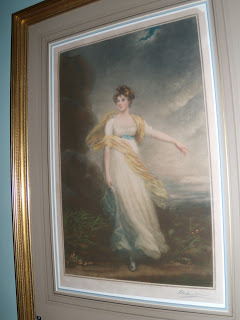 my photo of an engraving of Margaret Mercer Elphinstone at Bowood, after a portrait by Hoppner
my photo of an engraving of Margaret Mercer Elphinstone at Bowood, after a portrait by HoppnerMercer, as Charlotte called her, was herself an heiress and well-connected in London society. Her father was Admiral Lord Keith of the British Navy. The correspondence between Princess Charlotte and Meg Mercer lasted from 1811 until just before Charlotte's death in 1817. Although requested to return the letters to the Prince Regent, Mercer kept them in her possession. Through her daughter, who became the Marchioness of Lansdowne, the letters were held at Bowood House in Wiltshire. They were published in 1949, in a volume edited by Professor Arthur Aspinall (1901-72).
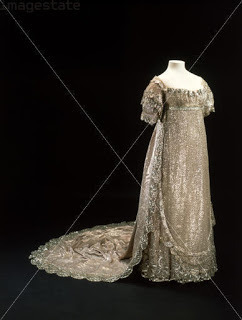 Princess Charlotte's wedding gown, 1816
Princess Charlotte's wedding gown, 1816The letters reveal a lively mind, if somewhat flighty, and a great interest in affairs of government on Charlotte's part. The last 18 months of her life, after her marriage to Leopold of Saxe Coburg in 1816, were generally happy, we are pleased to say. RIP, Charlotte.
Published on November 06, 2011 02:00
November 4, 2011
Report from Ft. Worth, The Book Launch
On Friday, October 14, 2011, many of the JASNA AGM attendees and other book lovers got together for a book launch at a nearby Barnes & Noble Bookstore in downtown Fort Worth. Three novels were introduced to the eager audience.
Carrie Bebris introduced the latest in her series of Mr. and Mrs. Darcy Mysteries, The Deception at Lyme. Take a look at her website here. Below, Carrie autographs her books for her fans.
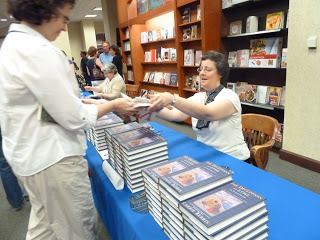
In this story, Mr. and Mrs. Darcy meet Captain Wentworth and his new wife, the former Anne Elliott in the seaside town of Lyme. When murder raises its ugly head, Darcy and Elizabeth identify the culprit, as they have in Pride and Prescience, Suspense and Sensibility, North by Northanger, The Matters at Mansfield, and The Intrigue at Highbury. In each novel, the Darcys encounter other characters created
by Jane Austen.
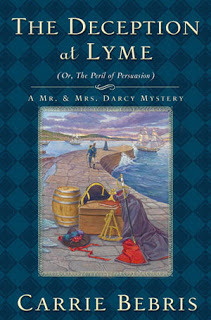
Janet Mullany's Jane Austen: Blood Persuasion brings the Damned to the village of Chawton. Janet's website is here. The story is a sequel to her 2010 novel Jane and the Damned. Janet's voyages into Jane Austen and the paranormal follow other "straight" regencies she has written for several publishers. Born in England, Janet now lives in the Washington DC vicinity.
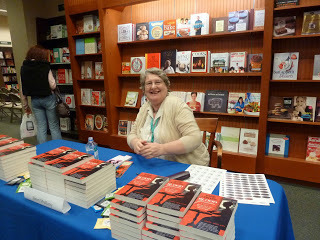
Though Jane is hoping to make progress on her latest novel, the arrival of the Damned brings her a whole host of problems -- including conflict with a former lover.
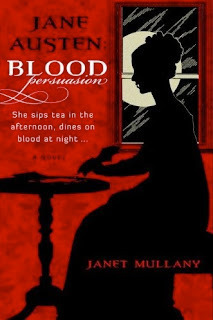
Laurel Ann Nattress is the editor and creator of a recently published antholodgy of original stories inspired by Jane Austen. Both Carrie Bebris and Janet Mullany are among the 24 authors who contributed to Jane Austen Made Me Do It.
For more information, click here. Below, Laurel meets fans. In the red bonnet behind her is Syrie James.
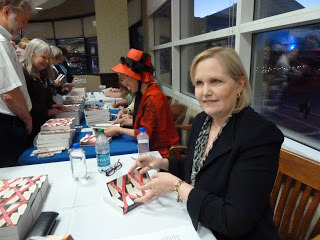
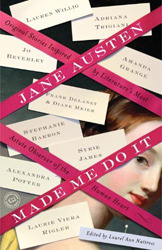
Below, Margaret Sullivan, Stephanie Barron, and Syrie's big red bonnet!
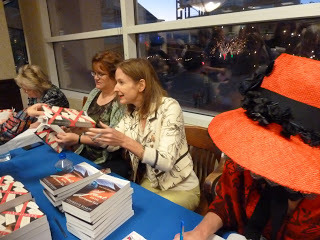
Book Launches are always fun, especialy when they are attended by so many fans -- and BUYERS!!
Carrie Bebris introduced the latest in her series of Mr. and Mrs. Darcy Mysteries, The Deception at Lyme. Take a look at her website here. Below, Carrie autographs her books for her fans.

In this story, Mr. and Mrs. Darcy meet Captain Wentworth and his new wife, the former Anne Elliott in the seaside town of Lyme. When murder raises its ugly head, Darcy and Elizabeth identify the culprit, as they have in Pride and Prescience, Suspense and Sensibility, North by Northanger, The Matters at Mansfield, and The Intrigue at Highbury. In each novel, the Darcys encounter other characters created
by Jane Austen.

Janet Mullany's Jane Austen: Blood Persuasion brings the Damned to the village of Chawton. Janet's website is here. The story is a sequel to her 2010 novel Jane and the Damned. Janet's voyages into Jane Austen and the paranormal follow other "straight" regencies she has written for several publishers. Born in England, Janet now lives in the Washington DC vicinity.

Though Jane is hoping to make progress on her latest novel, the arrival of the Damned brings her a whole host of problems -- including conflict with a former lover.

Laurel Ann Nattress is the editor and creator of a recently published antholodgy of original stories inspired by Jane Austen. Both Carrie Bebris and Janet Mullany are among the 24 authors who contributed to Jane Austen Made Me Do It.
For more information, click here. Below, Laurel meets fans. In the red bonnet behind her is Syrie James.


Below, Margaret Sullivan, Stephanie Barron, and Syrie's big red bonnet!

Book Launches are always fun, especialy when they are attended by so many fans -- and BUYERS!!
Published on November 04, 2011 02:00
November 2, 2011
Excerpts from The Court Journal
Gazette of Fashionable Life
Saturday, November 2, 1833
COURT AND FASHIONABLE LIFE
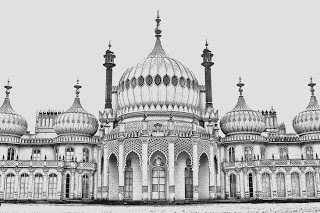
— The King and Queen arrived at the Pavilion at Brighton on Saturday afternoon in a travelling chariot, preceded by outriders. On their Majesties' arrival a Royal salute was fired from the battery, and a peal was rung on the bells of St Nicholas' tower. In the evening the town was enlivened with a brilliant display of fire-works, which was seen by their Majesties and suite from the windows of the Palace.
— Their Majesties have appeared in public every day since their arrival. On Wednesday the Queen, accompanied by the Earl and Countess Howe, Miss Mitchel (Maid of Honour), Lord Elphinston, and Lieut.-Colonel Horace Seymour (Equerry in Waiting), walked for some time on the Old Steyne; from thence the Royal party proceeded to the chain pier, and after passing over that part lately damaged, went on to the extremity, where her Majesty embarked on board Captain Brown's boat, which was rowed by Lieut. Colonel Seymour and the Gallant Captain, eastward, passing Kemp Town, to near Rottingdean, and back to the pier head, where her Majesty landed, and returned to the Palace, with her suite, after one o'clock.
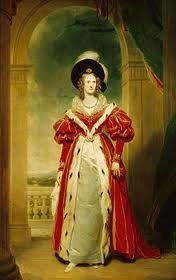 Queen Adelaide
Queen Adelaide
--- Her Majesty enjoyed a very delightful aquatic excursion on Thursday, in company with Lady Howe, Lord Errol, and Capt. Browne. The Royal party were at sea for more than two hours, and ventured, in consequence of the serenity of the day, upwards of four miles from the Chain Pier.
— We are happy to state that a letter has been received from his Royal Highness the Duke of Cumberland, which holds out some prospect of the restoration of the sight of Prince George. His medical attendant had reported to his Royal Highness that the applications he had made to the eyes of the young Prince were operating to the extent of his most favourable expectations, and he was far from being without hope that eventually a cure might be effected. The Royal Duke has, we believe, in consequence, engaged his house at Berlin for two years longer.
— The apartments of the Duchess of Kent and the Princess Victoria in Kensington Palace, are preparing for the reception of their Royal Highnesses, who are expected in town in the course of the ensuing week.
[image error] Compton Place
— The Earl and Countess of Burlington are expected to arrive at Burlington House, Piccadilly, in the ensuing week, where it is expected they will remain during the winter. The Earl and Countess are at present at his Lordship's beautiful seat, Compton Place, Eastbourne.— Lord Lansdowne comes to town shortly, from Bowood, Wilts; and Lord Grey is expected in a few days, from the North. The Minister's presence is looked for in the Grand Civic Banquet at Guildhall, to attend which several other Members of the Administration will visit the metropolis.
— Lady Georgiana Curzon, daughter of the Earl and Countess Howe, is a great favourite with their Majesties, and very frequently accompanies the King in his carriage drives. Lady Georgiana, who is the only daughter of the Earl and Countess, is now in her eighth year.
— Lord Holland is again indisposed by an attack of gout. His Lordship is in treaty for the mansion of the Countess of Sandwich, in Dover street, as a temporary residence for the ensuing season.
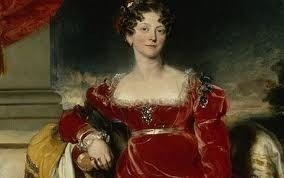 Princess Sophia by Lawrence— A paragraph has gone the round of the papers, stating that her Royal Highness the Princess Sophia, and Sir Henry Halford, her physician, are to be married, if the Parliament will consent to an act, authorizing her Royal Highness to espouse a Commoner. The long and intimate friendship subsisting between the Princess and Sir Henry, seems to have given rise to this extraordinary story.
Princess Sophia by Lawrence— A paragraph has gone the round of the papers, stating that her Royal Highness the Princess Sophia, and Sir Henry Halford, her physician, are to be married, if the Parliament will consent to an act, authorizing her Royal Highness to espouse a Commoner. The long and intimate friendship subsisting between the Princess and Sir Henry, seems to have given rise to this extraordinary story.
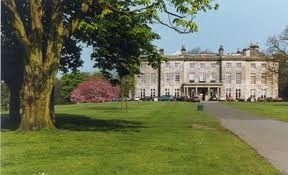 Haigh Hall
Haigh Hall
— Lord Lindsay, eldest son of the Earl of Balcarras, became of age on the 16th instant,when the event was celebrated at Haigh Hall, the seat of the Noble Earl, in Lancashire, and at Eastferry Abbey, in Fifeshire. Lord and Lady Balcarras and family have recenntly returned from a short Continental tour.— Sir John Cam Hobhouse has taken the mansion and estate of Basildon Park, near Reading, where the Right Hon. Baronet, with his lady (a sister of the Marquis of Tweedale) and family, will reside until the commencement of the next season.
— The Marquis and Marchioness of Ailesbury have taken their departure for the Continent. They proceed on a visit, in the first instance, to the Count and Countess Daniskiold at Stockholm. The stay of the Noble Marquis abroad is expected to be of some duration, his Lordship having much diminished his establishments, both at Tottenham Park, in Wiltshire, and in Grosvenor-squarc. The Marquis and Marchioness have been paying a farewell visit during the last week to the venerable Countess of Dysart (grandmother of her Ladyship), at Ham House, Richmond, where there was a party of the Tollcmache family assembled to meet them. Count and Countess Daniskiold (Lady Elizabeth Bruce) took their departure for Denmark some weeks ago. The Count is nearly allied to the reigning Royal Family of that country.
— Lord Ranelagh and Lord Lowther are on the Rhine with a very numerous circle of English fashionables. The Dowager Lady Ranelagh and the Lady Emily are also there.
— Lord Saye and Sele has been in town some days with his son, the Hon. Fynes Twisleton. His Lordship has quitted his late residence in Bruton-street for one more suitable in Lower Grosvenor-street.
[image error] Marchioness of Londonderry— The Marquis and Marchioness of Londonderry will entertain a large party of the Nobility, now in the North, at their magnificent seat, Wynyard House, in the ensuing month. The mansion has recently received a valuable acquisition in the splendid stained glass window, formerly the property of the Hon. Mrs Beaumont. French plays, in which the young daughters of the Marchioness (the Lady Seaham) are to sustain characters, will form part of the amusements.— Lieut-General Sir Hussey Vivian and his bride have arrived in town from Dublin. The gallant General's locum lenens, during his absence on leave, as Commandcr-in Chief of the Forces in Ireland, is Major-General Sir Edward Blakeney, K.C. B., of the Leinster district. Captain Charles Vivian, of the 7th Hussars, eldest son of Sir Hussey, is the new Military Secretary to his father, in the room of Colonel Lord Templemore, resigned. The duties, however, of this office are chiefly executed by the Assistant Secretary, Lieut. Siborn. The object of the gallant General's journey to the metropolis is understood to relate to military arrangements connected with the Irish Coercion Act, the five Lieutenant-Colonels employed under the provisions of that statute having been withdrawn.— The distinguished party assembled at the Duke of Grafton's, at Euston Hall, have broken up and taken their departure for the Newmarket Houghton Meeting which will close the racing season for the present year.
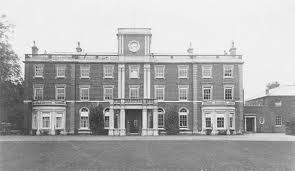 Sudbourne Hall— Prince Esterhazy and his son have left Chandos House for Sudbourne Hall, the magnificent seat of the Marquis of Hertford, in Suffolk, which, since the departure of his Lordship for Italy, has been entitled ' Paradise Lost.' The Prince from his long residence here is on the closest terms of intimacy with the Noble Marquis,who has accorded permission to his Highness and other persons of note to shoot over his preserves, which swarm with game from Sudbourne. The Prince proceeds to the Duke of Grafton's, at Euston, for a week.
Sudbourne Hall— Prince Esterhazy and his son have left Chandos House for Sudbourne Hall, the magnificent seat of the Marquis of Hertford, in Suffolk, which, since the departure of his Lordship for Italy, has been entitled ' Paradise Lost.' The Prince from his long residence here is on the closest terms of intimacy with the Noble Marquis,who has accorded permission to his Highness and other persons of note to shoot over his preserves, which swarm with game from Sudbourne. The Prince proceeds to the Duke of Grafton's, at Euston, for a week.
— The venerable Earl of Arran is seriously indisposed at Arran Lodge, Bognor.
— Sir Augustus Clifford, the Usher of the Black Rod, and his lady, the daughter of the late Lord John Townshend, are on their annual visit to his Grace the Duke of Devonshire, at Chatsworth, where a party of the Cavendish family are assembled. Sir Augustus Clifford, we believe, has not yet taken possession of the pleasant residence appended to his office, which is situated on the verge of the Thames, immediately behind the House of Lords. The house is, however, in a dilapidated condition, and will require substantial repairs before it can be fit for the reception of his family.
Court Carriages. — At the Congress of Vienna, the Emperor of Austria wishing that none of the Sovereigns or persons of their suite should use any carriages but his, ordered three hundred to be prepared all alike. At every hour of the day ai:d night, these carriages were at the service of his illustrious visitors—some of them with four horses, others with two, were to be met with in every direction.
[image error] Hornby Castle— The Duke and Duchess of Leeds have been entertaining their relatives and friends at his Grace's splendid establishment, Hornby Castle. Mr and Lady Charlotte Lane Pox have been staying during the last week at Gwydyr House, the magnificent mansion purchased by the Duke from Lord Willoughby d'Eresby. They return to Yorkshire in a few days.— On Wednesday week, Earl Grey gave a Ball to his domestics, and their friends and acquaintances, at Howick Hall, amounting to nearly 200. Dancing commenced about nine o'clock, and was kept up with great spirit until five o'clock in the morning, when the company separated highly gratified. In the course of the evening, the Noble Earl and his amiable Countess, Viscount and Viscountess Howick, the Honourable Colonel and John Grey, Lady Georgiana Grey, Sir Henry and Lady Grey, of Falloden, the Hon. Mr, Mrs and Miss Ponsonhy, Lord Russell, and the Hon. H. T. Liddell, honoured the company with their presence, and part of them joined in the dance. It was held in the great entrance hall, and refreshments were served up to the company in the true style of old English hospitality.

Saturday, November 2, 1833
COURT AND FASHIONABLE LIFE

— The King and Queen arrived at the Pavilion at Brighton on Saturday afternoon in a travelling chariot, preceded by outriders. On their Majesties' arrival a Royal salute was fired from the battery, and a peal was rung on the bells of St Nicholas' tower. In the evening the town was enlivened with a brilliant display of fire-works, which was seen by their Majesties and suite from the windows of the Palace.
— Their Majesties have appeared in public every day since their arrival. On Wednesday the Queen, accompanied by the Earl and Countess Howe, Miss Mitchel (Maid of Honour), Lord Elphinston, and Lieut.-Colonel Horace Seymour (Equerry in Waiting), walked for some time on the Old Steyne; from thence the Royal party proceeded to the chain pier, and after passing over that part lately damaged, went on to the extremity, where her Majesty embarked on board Captain Brown's boat, which was rowed by Lieut. Colonel Seymour and the Gallant Captain, eastward, passing Kemp Town, to near Rottingdean, and back to the pier head, where her Majesty landed, and returned to the Palace, with her suite, after one o'clock.
 Queen Adelaide
Queen Adelaide--- Her Majesty enjoyed a very delightful aquatic excursion on Thursday, in company with Lady Howe, Lord Errol, and Capt. Browne. The Royal party were at sea for more than two hours, and ventured, in consequence of the serenity of the day, upwards of four miles from the Chain Pier.
— We are happy to state that a letter has been received from his Royal Highness the Duke of Cumberland, which holds out some prospect of the restoration of the sight of Prince George. His medical attendant had reported to his Royal Highness that the applications he had made to the eyes of the young Prince were operating to the extent of his most favourable expectations, and he was far from being without hope that eventually a cure might be effected. The Royal Duke has, we believe, in consequence, engaged his house at Berlin for two years longer.
— The apartments of the Duchess of Kent and the Princess Victoria in Kensington Palace, are preparing for the reception of their Royal Highnesses, who are expected in town in the course of the ensuing week.
[image error] Compton Place
— The Earl and Countess of Burlington are expected to arrive at Burlington House, Piccadilly, in the ensuing week, where it is expected they will remain during the winter. The Earl and Countess are at present at his Lordship's beautiful seat, Compton Place, Eastbourne.— Lord Lansdowne comes to town shortly, from Bowood, Wilts; and Lord Grey is expected in a few days, from the North. The Minister's presence is looked for in the Grand Civic Banquet at Guildhall, to attend which several other Members of the Administration will visit the metropolis.
— Lady Georgiana Curzon, daughter of the Earl and Countess Howe, is a great favourite with their Majesties, and very frequently accompanies the King in his carriage drives. Lady Georgiana, who is the only daughter of the Earl and Countess, is now in her eighth year.
— Lord Holland is again indisposed by an attack of gout. His Lordship is in treaty for the mansion of the Countess of Sandwich, in Dover street, as a temporary residence for the ensuing season.
 Princess Sophia by Lawrence— A paragraph has gone the round of the papers, stating that her Royal Highness the Princess Sophia, and Sir Henry Halford, her physician, are to be married, if the Parliament will consent to an act, authorizing her Royal Highness to espouse a Commoner. The long and intimate friendship subsisting between the Princess and Sir Henry, seems to have given rise to this extraordinary story.
Princess Sophia by Lawrence— A paragraph has gone the round of the papers, stating that her Royal Highness the Princess Sophia, and Sir Henry Halford, her physician, are to be married, if the Parliament will consent to an act, authorizing her Royal Highness to espouse a Commoner. The long and intimate friendship subsisting between the Princess and Sir Henry, seems to have given rise to this extraordinary story.
 Haigh Hall
Haigh Hall— Lord Lindsay, eldest son of the Earl of Balcarras, became of age on the 16th instant,when the event was celebrated at Haigh Hall, the seat of the Noble Earl, in Lancashire, and at Eastferry Abbey, in Fifeshire. Lord and Lady Balcarras and family have recenntly returned from a short Continental tour.— Sir John Cam Hobhouse has taken the mansion and estate of Basildon Park, near Reading, where the Right Hon. Baronet, with his lady (a sister of the Marquis of Tweedale) and family, will reside until the commencement of the next season.
— The Marquis and Marchioness of Ailesbury have taken their departure for the Continent. They proceed on a visit, in the first instance, to the Count and Countess Daniskiold at Stockholm. The stay of the Noble Marquis abroad is expected to be of some duration, his Lordship having much diminished his establishments, both at Tottenham Park, in Wiltshire, and in Grosvenor-squarc. The Marquis and Marchioness have been paying a farewell visit during the last week to the venerable Countess of Dysart (grandmother of her Ladyship), at Ham House, Richmond, where there was a party of the Tollcmache family assembled to meet them. Count and Countess Daniskiold (Lady Elizabeth Bruce) took their departure for Denmark some weeks ago. The Count is nearly allied to the reigning Royal Family of that country.
— Lord Ranelagh and Lord Lowther are on the Rhine with a very numerous circle of English fashionables. The Dowager Lady Ranelagh and the Lady Emily are also there.
— Lord Saye and Sele has been in town some days with his son, the Hon. Fynes Twisleton. His Lordship has quitted his late residence in Bruton-street for one more suitable in Lower Grosvenor-street.
[image error] Marchioness of Londonderry— The Marquis and Marchioness of Londonderry will entertain a large party of the Nobility, now in the North, at their magnificent seat, Wynyard House, in the ensuing month. The mansion has recently received a valuable acquisition in the splendid stained glass window, formerly the property of the Hon. Mrs Beaumont. French plays, in which the young daughters of the Marchioness (the Lady Seaham) are to sustain characters, will form part of the amusements.— Lieut-General Sir Hussey Vivian and his bride have arrived in town from Dublin. The gallant General's locum lenens, during his absence on leave, as Commandcr-in Chief of the Forces in Ireland, is Major-General Sir Edward Blakeney, K.C. B., of the Leinster district. Captain Charles Vivian, of the 7th Hussars, eldest son of Sir Hussey, is the new Military Secretary to his father, in the room of Colonel Lord Templemore, resigned. The duties, however, of this office are chiefly executed by the Assistant Secretary, Lieut. Siborn. The object of the gallant General's journey to the metropolis is understood to relate to military arrangements connected with the Irish Coercion Act, the five Lieutenant-Colonels employed under the provisions of that statute having been withdrawn.— The distinguished party assembled at the Duke of Grafton's, at Euston Hall, have broken up and taken their departure for the Newmarket Houghton Meeting which will close the racing season for the present year.
 Sudbourne Hall— Prince Esterhazy and his son have left Chandos House for Sudbourne Hall, the magnificent seat of the Marquis of Hertford, in Suffolk, which, since the departure of his Lordship for Italy, has been entitled ' Paradise Lost.' The Prince from his long residence here is on the closest terms of intimacy with the Noble Marquis,who has accorded permission to his Highness and other persons of note to shoot over his preserves, which swarm with game from Sudbourne. The Prince proceeds to the Duke of Grafton's, at Euston, for a week.
Sudbourne Hall— Prince Esterhazy and his son have left Chandos House for Sudbourne Hall, the magnificent seat of the Marquis of Hertford, in Suffolk, which, since the departure of his Lordship for Italy, has been entitled ' Paradise Lost.' The Prince from his long residence here is on the closest terms of intimacy with the Noble Marquis,who has accorded permission to his Highness and other persons of note to shoot over his preserves, which swarm with game from Sudbourne. The Prince proceeds to the Duke of Grafton's, at Euston, for a week.— The venerable Earl of Arran is seriously indisposed at Arran Lodge, Bognor.
— Sir Augustus Clifford, the Usher of the Black Rod, and his lady, the daughter of the late Lord John Townshend, are on their annual visit to his Grace the Duke of Devonshire, at Chatsworth, where a party of the Cavendish family are assembled. Sir Augustus Clifford, we believe, has not yet taken possession of the pleasant residence appended to his office, which is situated on the verge of the Thames, immediately behind the House of Lords. The house is, however, in a dilapidated condition, and will require substantial repairs before it can be fit for the reception of his family.
Court Carriages. — At the Congress of Vienna, the Emperor of Austria wishing that none of the Sovereigns or persons of their suite should use any carriages but his, ordered three hundred to be prepared all alike. At every hour of the day ai:d night, these carriages were at the service of his illustrious visitors—some of them with four horses, others with two, were to be met with in every direction.
[image error] Hornby Castle— The Duke and Duchess of Leeds have been entertaining their relatives and friends at his Grace's splendid establishment, Hornby Castle. Mr and Lady Charlotte Lane Pox have been staying during the last week at Gwydyr House, the magnificent mansion purchased by the Duke from Lord Willoughby d'Eresby. They return to Yorkshire in a few days.— On Wednesday week, Earl Grey gave a Ball to his domestics, and their friends and acquaintances, at Howick Hall, amounting to nearly 200. Dancing commenced about nine o'clock, and was kept up with great spirit until five o'clock in the morning, when the company separated highly gratified. In the course of the evening, the Noble Earl and his amiable Countess, Viscount and Viscountess Howick, the Honourable Colonel and John Grey, Lady Georgiana Grey, Sir Henry and Lady Grey, of Falloden, the Hon. Mr, Mrs and Miss Ponsonhy, Lord Russell, and the Hon. H. T. Liddell, honoured the company with their presence, and part of them joined in the dance. It was held in the great entrance hall, and refreshments were served up to the company in the true style of old English hospitality.
Published on November 02, 2011 00:25
October 31, 2011
The Bicentenary of Sense and Sensibility
Here we are, exactly two hundred years from the day that Jane Austen's first published novel, Sense and Sensibility, was published. Wheeeee!!! Hurrah for you, Jane.
Last April, the 25th to be exact, I blogged here about Miss Austen's work in April, 1811, correcting proofs for her first novel, the work she could no more forget "than a mother can forget her sucking child." In that letter from London to Cassandra at brother Edward's estate of Godmersham in Kent, she hoped to see the published book, if not in June, then soon thereafter. But it was delayed until the very end of October.
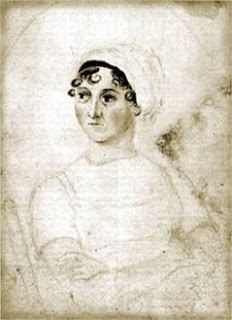
If you are a published author, or if you know of one, then you are well aware of the excitement with which Jane Austen must have viewed the first advertisements for her novel, then to see it for sale and hold it in her hands. Speaking for myself (Victoria here), such experiences were among the highlights of my life. And every author I have known felt the same way, so the sucking child analogy resonates, as so many people say these days (when did all these resonances become so widespread?)
Jane Austen was back in Chawton by Jun 811 and we no more of her letters until October 1812, so we cannot say what her reaction to seeing -- holding -- clasping her first novel was specifically. We have to use our imaginations. I see her holding the volumes high and spinning around the room in high excitement -- but not in front of anyone. All by herself. Perhaps only to Cassandra did she confide her delight. Or perhaps went into the garden and just stared at that title page. Sense and Sensibility, A Novel in three volumes, By A Lady.
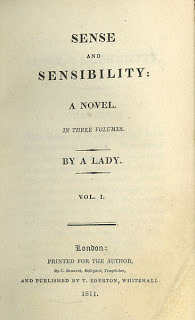
Or perhaps, if the day it arrived in her hands was sunny, she skipped over to the walled garden of Chawton House and found a ripened apple to eat while she turned the pages of the finished product. Once when I was at Chawton (it was 2003, to be exact), the gardener gave some of us a tour and he pulled some apples from the old gnarled trees, assuring us that these were the exact trees from which Jane would have picked. I felt like I was eating something VERY special. I forgot to ask the last time I was there in 2009 whether they had successfully grafted shoots from these ancient apple trees onto younger stock as the Head Gardener was planning.

This anniversary has been celebrated all over the world and I am delighted to add my tuppence to the cheers I can hear all the way from your computer to mine. Congratulations, my dear Jane. I feel a personal camaraderie with you today. Three cheers!!! Or, rather, several hundred.
[image error]
Last April, the 25th to be exact, I blogged here about Miss Austen's work in April, 1811, correcting proofs for her first novel, the work she could no more forget "than a mother can forget her sucking child." In that letter from London to Cassandra at brother Edward's estate of Godmersham in Kent, she hoped to see the published book, if not in June, then soon thereafter. But it was delayed until the very end of October.

If you are a published author, or if you know of one, then you are well aware of the excitement with which Jane Austen must have viewed the first advertisements for her novel, then to see it for sale and hold it in her hands. Speaking for myself (Victoria here), such experiences were among the highlights of my life. And every author I have known felt the same way, so the sucking child analogy resonates, as so many people say these days (when did all these resonances become so widespread?)
Jane Austen was back in Chawton by Jun 811 and we no more of her letters until October 1812, so we cannot say what her reaction to seeing -- holding -- clasping her first novel was specifically. We have to use our imaginations. I see her holding the volumes high and spinning around the room in high excitement -- but not in front of anyone. All by herself. Perhaps only to Cassandra did she confide her delight. Or perhaps went into the garden and just stared at that title page. Sense and Sensibility, A Novel in three volumes, By A Lady.

Or perhaps, if the day it arrived in her hands was sunny, she skipped over to the walled garden of Chawton House and found a ripened apple to eat while she turned the pages of the finished product. Once when I was at Chawton (it was 2003, to be exact), the gardener gave some of us a tour and he pulled some apples from the old gnarled trees, assuring us that these were the exact trees from which Jane would have picked. I felt like I was eating something VERY special. I forgot to ask the last time I was there in 2009 whether they had successfully grafted shoots from these ancient apple trees onto younger stock as the Head Gardener was planning.

This anniversary has been celebrated all over the world and I am delighted to add my tuppence to the cheers I can hear all the way from your computer to mine. Congratulations, my dear Jane. I feel a personal camaraderie with you today. Three cheers!!! Or, rather, several hundred.
[image error]
Published on October 31, 2011 02:00
October 29, 2011
The Wellington Connection: Mistaken Identity
[image error]
copyright the Brussels Bronte Group
From: Three Years With the Duke, or Wellington in Private Life (1853) by Lord William Pitt Lennox (younger son of the Duke of Richmond)
The theatre in the Park (in Brussels 1814) was opened, under the management of Mr. Penley, with a company of English players. The comedy of John Bull was the first performance, and attracted a most crowded and fashionable audience. Throughout the day, it had been hinted at the box-office, that the Duke of Wellington would probably attend the evening's performance, and a private box had been kept back under this hope. The Duke's avocations, however, prevented his making his appearance upon this occasion, as he had already informed the manager, when asked to patronise the play. This nearly led to a ludicrous mistake—a young officer and myself had been dining in company with the Duke, and, with that good-nature and consideration for which he was famed, he gave us permission to attend the theatre, telling us we might take his carriage after it had set him down. Upon reaching the Park, the carriage was recognised, and a crowd immediately followed it. As we gained the entrance of the theatre, the name of Wellington rent the air. This was communicated to the manager, who thrust his head out from behind the curtain, to give a signal to the leader of the band to play, "See the conquering hero comes!" The report spread like wildfire. The performances ceased—all eyes were anxiously fixed on the vacant box.
In the meantime, we had jumped out of the carriage, had tendered our money, and were surprised at the obsequiousness of the box-keeper, who, thinking we were the precursers of the Duke, begged us to walk into the lobby. The manager, or some official personage, had rushed into the private box to prepare the seats, and there awaited the welcome visiter. We now began to see the mistake that we had unwittingly caused; and, anxious to explain it, we approached the now open box-door. No sooner were our uniforms visible, than the band struck up the heart-stirring melody. In vain did we try to correct the error: the audience had risen, en masse; shouts re-echoed throughout the house; the curtain was drawn up, and the company came forward to sing the national song of "God save the King:" but no Duke of Wellington appeared.
For some minutes the cheers continued, when at length it was announced from the stage, that a slight mistake had occurred— that the avocations of the noble Duke had prevented his attendance; and, after the excitement had a little subsided, my young friend and myself sneaked quietly into the box, placing ourselves behind the curtain, fearful of calling the attention of the public to two mere urchins, who so unintentionally had nearly received the honours due to their chief.
From: Three Years With the Duke, or Wellington in Private Life (1853) by Lord William Pitt Lennox (younger son of the Duke of Richmond)
The theatre in the Park (in Brussels 1814) was opened, under the management of Mr. Penley, with a company of English players. The comedy of John Bull was the first performance, and attracted a most crowded and fashionable audience. Throughout the day, it had been hinted at the box-office, that the Duke of Wellington would probably attend the evening's performance, and a private box had been kept back under this hope. The Duke's avocations, however, prevented his making his appearance upon this occasion, as he had already informed the manager, when asked to patronise the play. This nearly led to a ludicrous mistake—a young officer and myself had been dining in company with the Duke, and, with that good-nature and consideration for which he was famed, he gave us permission to attend the theatre, telling us we might take his carriage after it had set him down. Upon reaching the Park, the carriage was recognised, and a crowd immediately followed it. As we gained the entrance of the theatre, the name of Wellington rent the air. This was communicated to the manager, who thrust his head out from behind the curtain, to give a signal to the leader of the band to play, "See the conquering hero comes!" The report spread like wildfire. The performances ceased—all eyes were anxiously fixed on the vacant box.
In the meantime, we had jumped out of the carriage, had tendered our money, and were surprised at the obsequiousness of the box-keeper, who, thinking we were the precursers of the Duke, begged us to walk into the lobby. The manager, or some official personage, had rushed into the private box to prepare the seats, and there awaited the welcome visiter. We now began to see the mistake that we had unwittingly caused; and, anxious to explain it, we approached the now open box-door. No sooner were our uniforms visible, than the band struck up the heart-stirring melody. In vain did we try to correct the error: the audience had risen, en masse; shouts re-echoed throughout the house; the curtain was drawn up, and the company came forward to sing the national song of "God save the King:" but no Duke of Wellington appeared.
For some minutes the cheers continued, when at length it was announced from the stage, that a slight mistake had occurred— that the avocations of the noble Duke had prevented his attendance; and, after the excitement had a little subsided, my young friend and myself sneaked quietly into the box, placing ourselves behind the curtain, fearful of calling the attention of the public to two mere urchins, who so unintentionally had nearly received the honours due to their chief.
Published on October 29, 2011 00:18
Kristine Hughes's Blog
- Kristine Hughes's profile
- 6 followers
Kristine Hughes isn't a Goodreads Author
(yet),
but they
do have a blog,
so here are some recent posts imported from
their feed.


